seats Lancia Thesis 2007 Owner handbook (in English)
[x] Cancel search | Manufacturer: LANCIA, Model Year: 2007, Model line: Thesis, Model: Lancia Thesis 2007Pages: 386, PDF Size: 8.69 MB
Page 84 of 386
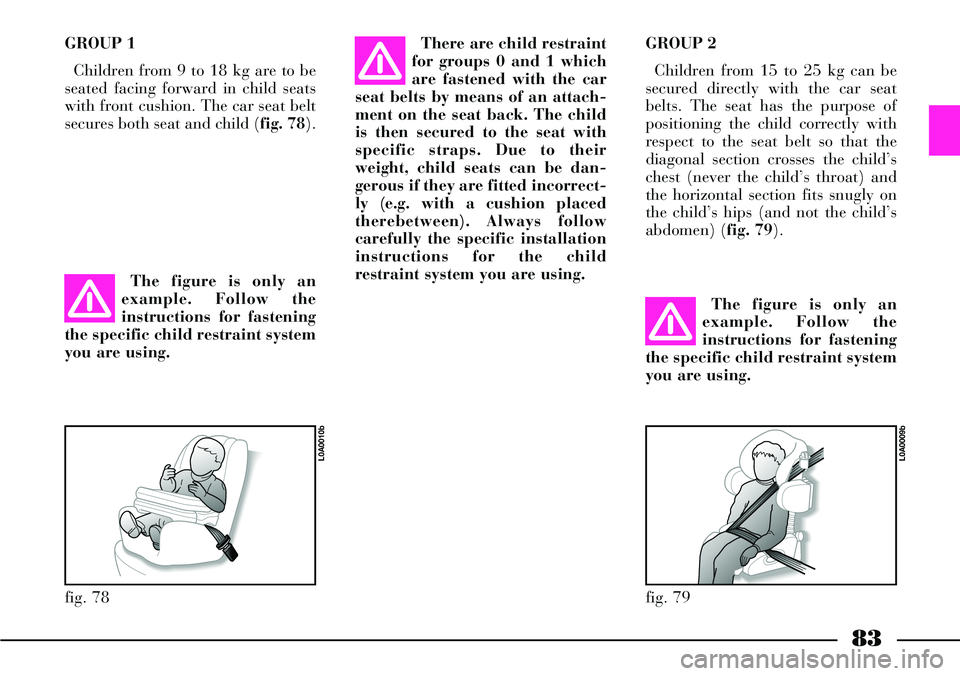
83
GROUP 1
Children from 9 to 18 kg are to be
seated facing forward in child seats
with front cushion. The car seat belt
secures both seat and child (fig. 78).There are child restraint
for groups 0 and 1 which
are fastened with the car
seat belts by means of an attach-
ment on the seat back. The child
is then secured to the seat with
specific straps. Due to their
weight, child seats can be dan-
gerous if they are fitted incorrect-
ly (e.g. with a cushion placed
therebetween). Always follow
carefully the specific installation
instructions for the child
restraint system you are using.GROUP 2
Children from 15 to 25 kg can be
secured directly with the car seat
belts. The seat has the purpose of
positioning the child correctly with
respect to the seat belt so that the
diagonal section crosses the child’s
chest (never the child’s throat) and
the horizontal section fits snugly on
the child’s hips (and not the child’s
abdomen) (fig. 79).
The figure is only an
example. Follow the
instructions for fastening
the specific child restraint system
you are using.The figure is only an
example. Follow the
instructions for fastening
the specific child restraint system
you are using.
fig. 78
L0A0010b
fig. 79
L0A0009b
Page 85 of 386
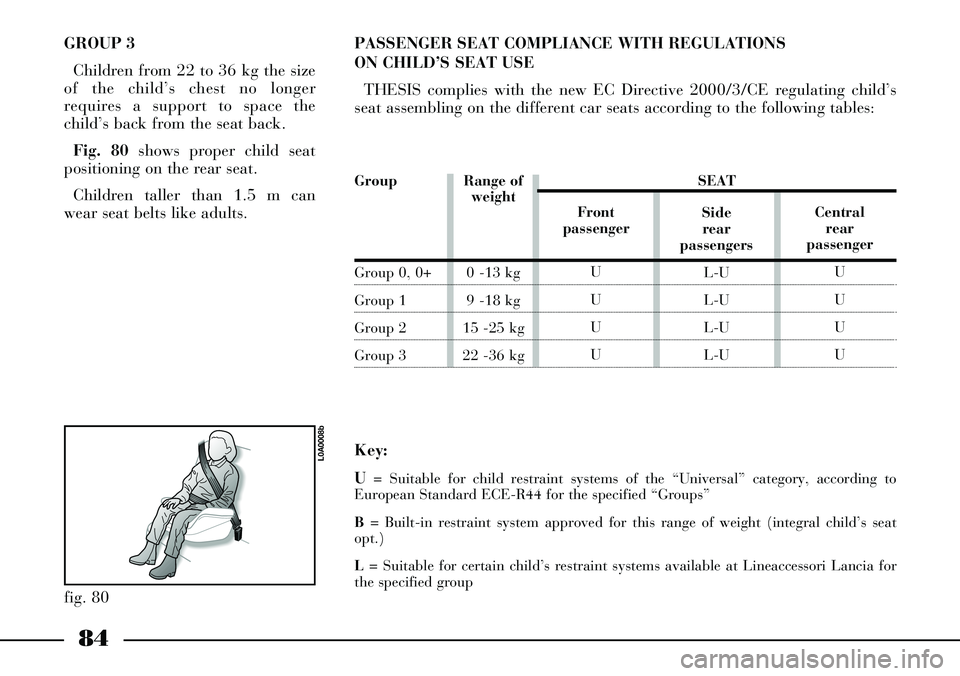
84
GROUP 3
Children from 22 to 36 kg the size
of the child’s chest no longer
requires a support to space the
child’s back from the seat back.
Fig. 80shows proper child seat
positioning on the rear seat.
Children taller than 1.5 m can
wear seat belts like adults.PASSENGER SEAT COMPLIANCE WITH REGULATIONS
ON CHILD’S SEAT USE
THESIS complies with the new EC Directive 2000/3/CE regulating child’s
seat assembling on the different car seats according to the following tables:
Group
Group 0, 0+
Group 1
Group 2
Group 3
Key:
U
= Suitable for child restraint systems of the “Universal” category, according to
European Standard ECE-R44 for the specified “Groups”
B = Built-in restraint system approved for this range of weight (integral child’s seat
opt.)
L = Suitable for certain child’s restraint systems available at Lineaccessori Lancia for
the specified group
fig. 80
L0A0008b
SEAT
Front
passenger
U
U
U
USide
rear
passengers
L-U
L-U
L-U
L-UCentral
rear
passenger
U
U
U
U Range of
weight
0 -13 kg
9 -18 kg
15 -25 kg
22 -36 kg
Page 86 of 386
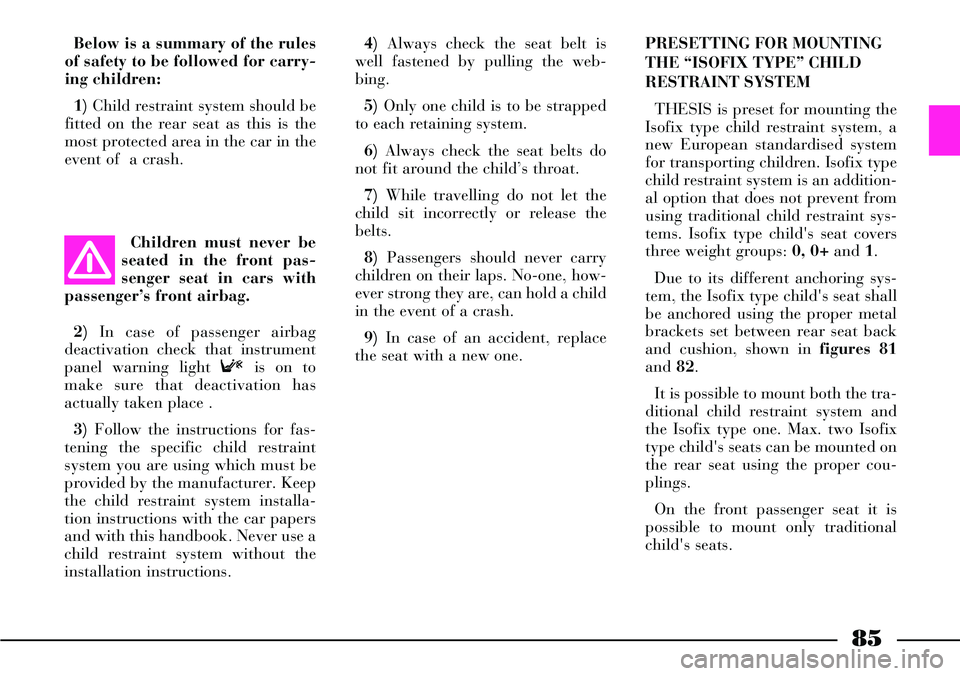
85
Below is a summary of the rules
of safety to be followed for carry-
ing children:
1) Child restraint system should be
fitted on the rear seat as this is the
most protected area in the car in the
event of a crash.4) Always check the seat belt is
well fastened by pulling the web-
bing.
5) Only one child is to be strapped
to each retaining system.
6) Always check the seat belts do
not fit around the child’s throat.
7) While travelling do not let the
child sit incorrectly or release the
belts.
8) Passengers should never carry
children on their laps. No-one, how-
ever strong they are, can hold a child
in the event of a crash.
9) In case of an accident, replace
the seat with a new one.PRESETTING FOR MOUNTING
THE “ISOFIX TYPE” CHILD
RESTRAINT SYSTEM
THESIS is preset for mounting the
Isofix type child restraint system, a
new European standardised system
for transporting children. Isofix type
child restraint system is an addition-
al option that does not prevent from
using traditional child restraint sys-
tems. Isofix type child's seat covers
three weight groups: 0, 0+and 1.
Due to its different anchoring sys-
tem, the Isofix type child's seat shall
be anchored using the proper metal
brackets set between rear seat back
and cushion, shown in figures 81
and82.
It is possible to mount both the tra-
ditional child restraint system and
the Isofix type one. Max. two Isofix
type child's seats can be mounted on
the rear seat using the proper cou-
plings.
On the front passenger seat it is
possible to mount only traditional
child's seats. Children must never be
seated in the front pas-
senger seat in cars with
passenger’s front airbag.
2) In case of passenger airbag
deactivation check that instrument
panel warning light Fis on to
make sure that deactivation has
actually taken place .
3) Follow the instructions for fas-
tening the specific child restraint
system you are using which must be
provided by the manufacturer. Keep
the child restraint system installa-
tion instructions with the car papers
and with this handbook. Never use a
child restraint system without the
installation instructions.
Page 93 of 386
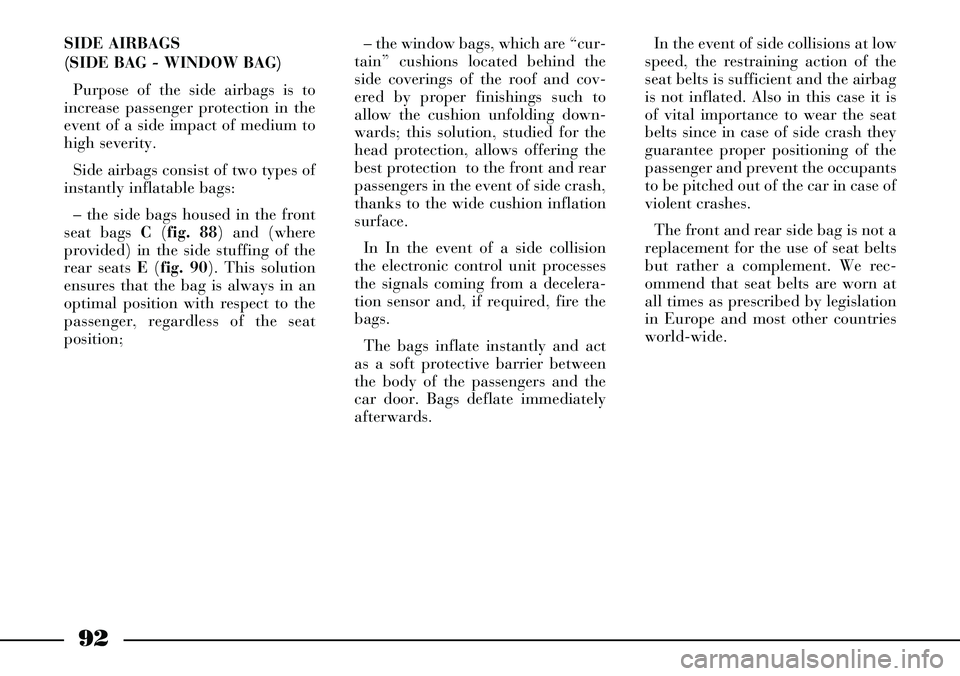
In the event of side collisions at low
speed, the restraining action of the
seat belts is sufficient and the airbag
is not inflated. Also in this case it is
of vital importance to wear the seat
belts since in case of side crash they
guarantee proper positioning of the
passenger and prevent the occupants
to be pitched out of the car in case of
violent crashes.
The front and rear side bag is not a
replacement for the use of seat belts
but rather a complement. We rec-
ommend that seat belts are worn at
all times as prescribed by legislation
in Europe and most other countries
world-wide.
92
SIDE AIRBAGS
(SIDE BAG - WINDOW BAG)
Purpose of the side airbags is to
increase passenger protection in the
event of a side impact of medium to
high severity.
Side airbags consist of two types of
instantly inflatable bags:
– the side bags housed in the front
seat bags C (fig. 88) and (where
provided) in the side stuffing of the
rear seats E (fig. 90). This solution
ensures that the bag is always in an
optimal position with respect to the
passenger, regardless of the seat
position;– the window bags, which are “cur-
tain” cushions located behind the
side coverings of the roof and cov-
ered by proper finishings such to
allow the cushion unfolding down-
wards; this solution, studied for the
head protection, allows offering the
best protection to the front and rear
passengers in the event of side crash,
thanks to the wide cushion inflation
surface.
In In the event of a side collision
the electronic control unit processes
the signals coming from a decelera-
tion sensor and, if required, fire the
bags.
The bags inflate instantly and act
as a soft protective barrier between
the body of the passengers and the
car door. Bags deflate immediately
afterwards.
Page 95 of 386
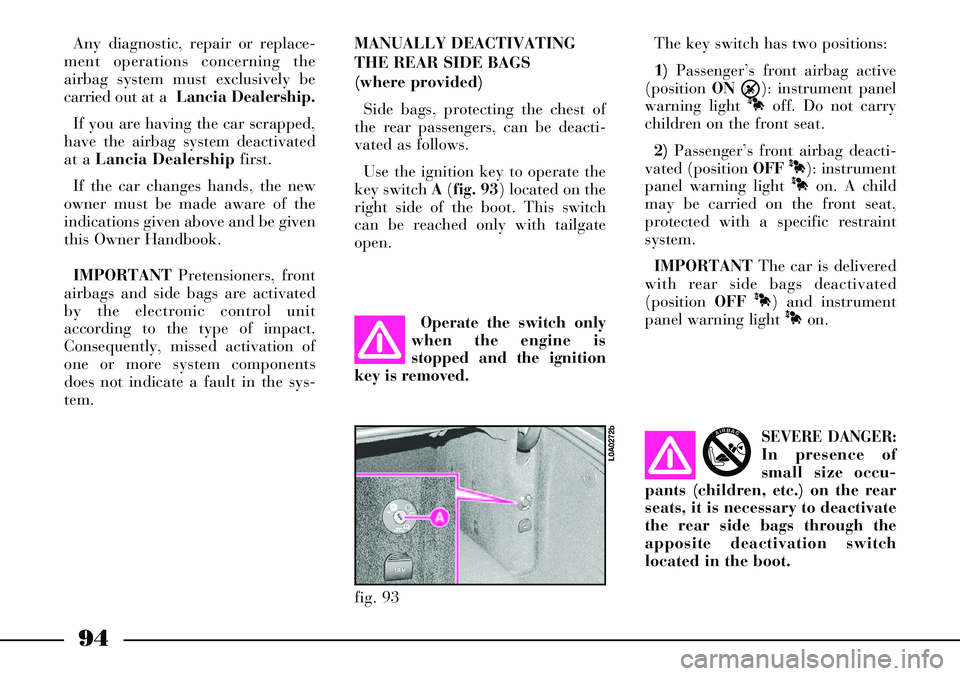
94
fig. 93
L0A0272b
Any diagnostic, repair or replace-
ment operations concerning the
airbag system must exclusively be
carried out at a Lancia Dealership.
If you are having the car scrapped,
have the airbag system deactivated
at a Lancia Dealershipfirst.
If the car changes hands, the new
owner must be made aware of the
indications given above and be given
this Owner Handbook.
IMPORTANTPretensioners, front
airbags and side bags are activated
by the electronic control unit
according to the type of impact.
Consequently, missed activation of
one or more system components
does not indicate a fault in the sys-
tem.MANUALLY DEACTIVATING
THE REAR SIDE BAGS
(where provided)
Side bags, protecting the chest of
the rear passengers, can be deacti-
vated as follows.
Use the ignition key to operate the
key switch A(fig. 93) located on the
right side of the boot. This switch
can be reached only with tailgate
open.The key switch has two positions:
1)Passenger’s front airbag active
(position ON
Õ): instrument panel
warning light
Àoff. Do not carry
children on the front seat.
2)Passenger’s front airbag deacti-
vated (position OFF
À): instrument
panel warning light
Àon. A child
may be carried on the front seat,
protected with a specific restraint
system.
IMPORTANTThe car is delivered
with rear side bags deactivated
(position OFF
À) and instrument
panel warning light
Àon.
Operate the switch only
when the engine is
stopped and the ignition
key is removed.
SEVERE DANGER:
In presence of
small size occu-
pants (children, etc.) on the rear
seats, it is necessary to deactivate
the rear side bags through the
apposite deactivation switch
located in the boot.
AIRBAG
Page 96 of 386
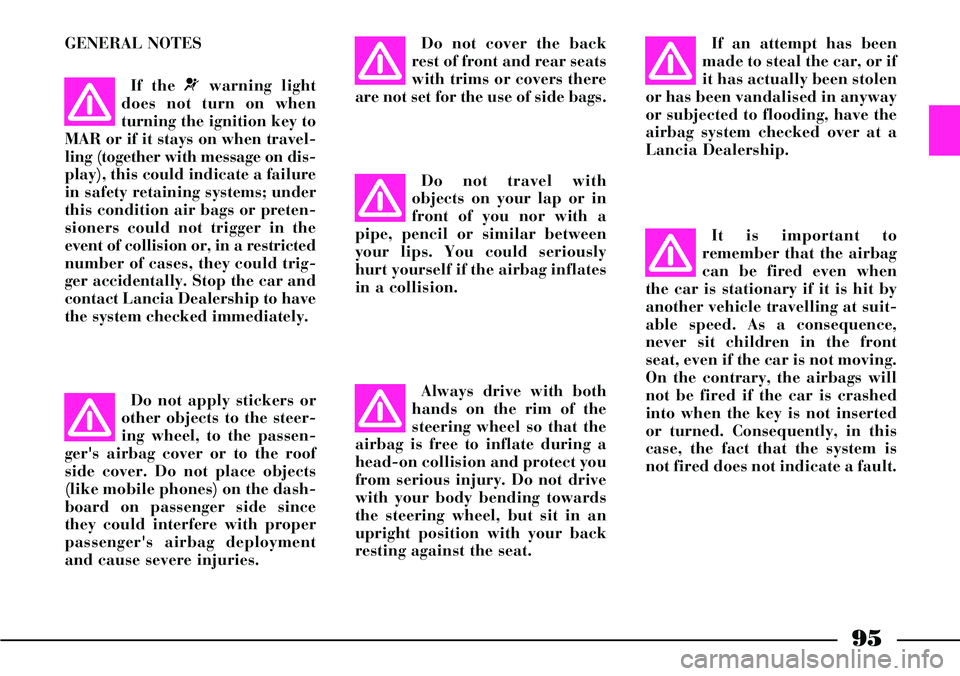
95
GENERAL NOTES
Do not apply stickers or
other objects to the steer-
ing wheel, to the passen-
ger's airbag cover or to the roof
side cover. Do not place objects
(like mobile phones) on the dash-
board on passenger side since
they could interfere with proper
passenger's airbag deployment
and cause severe injuries.
If the ¬warning light
does not turn on when
turning the ignition key to
MAR or if it stays on when travel-
ling (together with message on dis-
play), this could indicate a failure
in safety retaining systems; under
this condition air bags or preten-
sioners could not trigger in the
event of collision or, in a restricted
number of cases, they could trig-
ger accidentally. Stop the car and
contact Lancia Dealership to have
the system checked immediately.
Do not cover the back
rest of front and rear seats
with trims or covers there
are not set for the use of side bags.
Do not travel with
objects on your lap or in
front of you nor with a
pipe, pencil or similar between
your lips. You could seriously
hurt yourself if the airbag inflates
in a collision.
Always drive with both
hands on the rim of the
steering wheel so that the
airbag is free to inflate during a
head-on collision and protect you
from serious injury. Do not drive
with your body bending towards
the steering wheel, but sit in an
upright position with your back
resting against the seat.If an attempt has been
made to steal the car, or if
it has actually been stolen
or has been vandalised in anyway
or subjected to flooding, have the
airbag system checked over at a
Lancia Dealership.
It is important to
remember that the airbag
can be fired even when
the car is stationary if it is hit by
another vehicle travelling at suit-
able speed. As a consequence,
never sit children in the front
seat, even if the car is not moving.
On the contrary, the airbags will
not be fired if the car is crashed
into when the key is not inserted
or turned. Consequently, in this
case, the fact that the system is
not fired does not indicate a fault.
Page 147 of 386

146
AUTOMATIC
CLIMATE
CONTROL SYSTEM
GENERAL
The car can be equipped with a
two-zone or multi-zone automatic
climate control system.
The two-zone climate control sys-
tem controls temperature, air distri-
bution and flow inside the passenger
compartment in two areas: driver
side and passenger side.
The multi-zone climate control sys-
tem controls temperature, air distrib-
ution and flow inside the passenger
compartment in three areas: driver
side, passenger side or back-seat pas-
sengers.
Control of front-seat passenger and
back-seat passengers is alternated;
when the button led REARis turned
off, the front-seat passenger control
is operating, whereas when button
REARis pressed (button led turned
on), the back control panel is acti-
vated, thus excluding those for the
front-seat passenger.Temperature check is based on the
“heat balance” concept, which
means that the system works con-
stantly to keep a regular balance
between incoming and outgoing heat
energy, in order to stabilize temper-
ature inside the passenger compart-
ment and compensate possible vari-
ations of outside climate, sun radi-
ance included. For optimal control
of temperature in the two areas of
the passenger compartment, the sys-
tem is equipped with a sun ray sen-
sor.
The system features a pollution
sensor which can automatically
switch the air recirculation function
on to reduce the unpleasant effects
of polluted air in cities, queues, tun-
nels and when the windscreen wash-
er is operated (with the characteris-
tic smell of alcohol).
The air quality is controlled by an
active carbon dust/pollen filter
which has the double function of
mechanically filtering the particles
dispersed in the air and attenuating
the peak accumulation of certain
pollutants.Parameters and functions auto-
matically controlled are the follow-
ing:
– temperature of air let into dri-
ver/passenger vents (front-seat/
back-seats);
– air distribution to vents on dri-
ver/passenger side (front-seat/
back-seats);
– fan speed (continuos variation of
air flow);
– compressor activation (to cool
air);
– air recirculation.
All these functions can be adjusted
manually, it means that one or more
system functions can be selected and
that it is possible to change their
parameters. However, in this way
the system is unable to control man-
ually selected functions which will
be changed by the system only for
safety reasons, while keeping the
required temperature.
Page 150 of 386
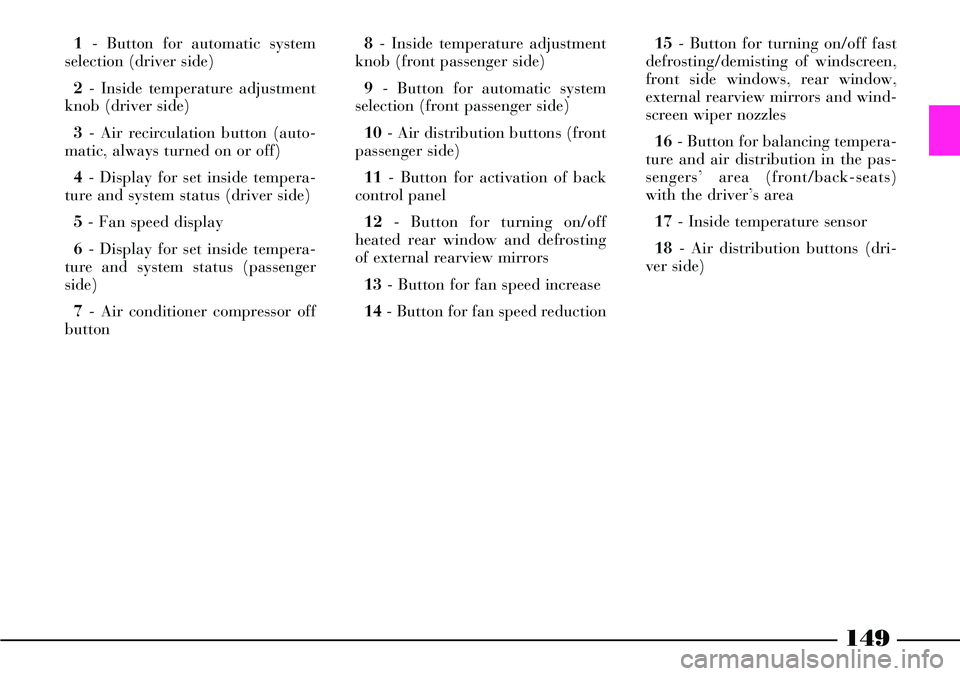
149
1- Button for automatic system
selection (driver side)
2- Inside temperature adjustment
knob (driver side)
3- Air recirculation button (auto-
matic, always turned on or off)
4- Display for set inside tempera-
ture and system status (driver side)
5- Fan speed display
6- Display for set inside tempera-
ture and system status (passenger
side)
7- Air conditioner compressor off
button 8- Inside temperature adjustment
knob (front passenger side)
9- Button for automatic system
selection (front passenger side)
10- Air distribution buttons (front
passenger side)
11- Button for activation of back
control panel
12- Button for turning on/off
heated rear window and defrosting
of external rearview mirrors
13- Button for fan speed increase
14- Button for fan speed reduction15- Button for turning on/off fast
defrosting/demisting of windscreen,
front side windows, rear window,
external rearview mirrors and wind-
screen wiper nozzles
16- Button for balancing tempera-
ture and air distribution in the pas-
sengers’ area (front/back-seats)
with the driver’s area
17- Inside temperature sensor
18- Air distribution buttons (dri-
ver side)
Page 216 of 386

215
FRONT ASHTRAY AND CIGAR
LIGHTER
The ashtray and cigar lighter are
protected by a single flap. Press the
flap in the point shown (fig. 165).
Press button A(fig. 166) to work
the cigar lighter. After a few seconds
it will return to its initial position
and be ready for use.
The cigar lighter will only work
when the ignition key is at MAR.
Remove tray Bto empty the ash-
tray.Always verify that the
cigar lighter has been
switched off.
The cigar lighter gets
very hot. Be careful how
you handle it and make
sure it is not used by children:
danger of fire or burns.REAR ASHTRAYS (fig. 167)
Two ashtrays are provided for rear
seats: they are incorporated into rear
door panels.
To open the ashtray, press on the
point specified by the arrow.
To empty the ashtray, remove tray
A.
fig. 165
L0A0189b
fig. 166
L0A0188b
fig. 167
L0A0053b
Page 220 of 386

219
REAR BOTTLE/CAN HOLDER
(fig. 178)
Bottle/can holder Ais incorporated
in the rear armrest.
To open it, press on the point spec-
ified by the arrow, then release it:
the bottle/can holder will automati-
cally open.
To close the bottle/can holder,
push it into its seat.REAR ARMREST
COMPARTMENT
Inside the rear armrest is an odd-
ment compartment A(fig. 179), a
card holder Band a power socket C.
Depending on versions, the armrest
can also include:
– the control buttons for heating,
massage, lumbar adjustment and for
adaptation of rear side seats
– the button to shift the front pas-
senger’s seat
– the button to actuate the electric
window shades
fig. 178
L0A0073b
fig. 179
L0A0075b
fig. 177
L0A0252b
CENTRAL CONSOLE
COMPARTMENT (fig. 177)
Versions with automatic, two-zone
climate control system are provided
with an oddment compartment A,
placed on the rear part of the central
console.